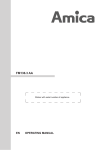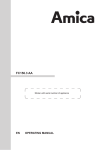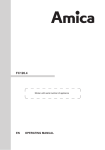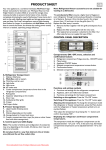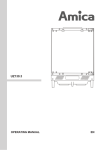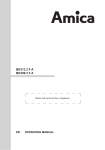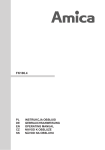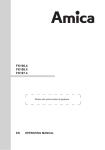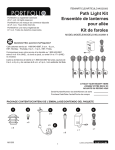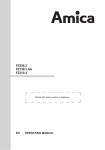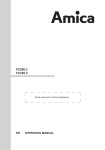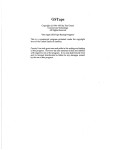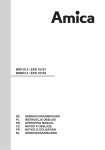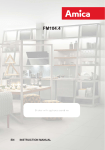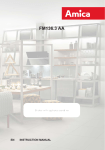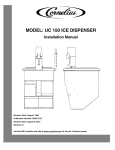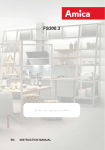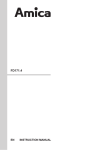Download Amica UC150.3 refrigerator
Transcript
UC150.3 OPERATING MANUAL EN EN GENERAL INFORMATION Dear Customer, The Amica appliance is a combination of exceptional user-friendliness and excellent efficiency. Prior to dispatch, each unit was carefully checked for its safety and operating capabilities. Before starting the appliance, please read this operating manual carefully. Note! This fridge-freezer is intended for use at home only. The manufacturer reserves the right to introduce modifications, which do not affect the operation of the appliance. The changes in the equipment, as well as the inside and outside decoration, which do not affect its functionality and safety are permissible. 2 TABLE OF CONTENTS Construction and equipment of the appliance...........................................................................4 Guidelines concerning the safety of use...................................................................................6 Installation.................................................................................................................................7 Operation and functions.............................................................................................................9 Using the refrigerator efficiently.................................................................................................12 Defrosting, washing and maintenance......................................................................................14 Trouble-shooting.......................................................................................................................16 Environmental protection..........................................................................................................18 Specification..............................................................................................................................19 3 CONSTRUCTION AND EQUIPMENT OF THE APPLIANCE Example 1 2 3 5 1. controls 2. Glass shelf 3. Glass container lid 4. Container 5. Large door shelf 6. Egg tray 7. Pusher 4 Additional equipment 7 6 The accurate description of the equipment for the model of the fridge purchased by you may be found in the tables on next pages. 4 CONSTRUCTION AND EQUIPMENT OF THE APPLIANCE Items of equipment Glass shelf UC150.3 2+1 Glass container lid 1 Container 2 Large door shelf 2 Type of lighting bulb Plunger 1 Egg Tray 1 5 GUIDELINES CONCERNING THE SAFETY OF USE l The Manufacturer shall not be held liable for the damage arising from the failure to observe the principles contained in this manual. l Keep this manual for future reference, or to pass it over to the possible next user. lThis appliance is not intended for use by persons (including children) with limited physical, sensual or psychical capabilities and persons who lack experience or familiarity with the appliance, unless attended or in accordance with the operating manual for the appliance delivered by persons responsible for their safety. l Do not allow the unattended children to use the appliance. Do not allow them to play with the appliance. They must climb inside the drawers and swing on the doors. lThe fridge-freezer operates properly at the N-ST ambient temperature. Do not use it in the cellar, unheated summer cottage during autumn and winter. lWhen placing, moving, lifting the appliance, do not hold the door handles, pull the condenser at the rear part of the refrigerator and touch the compressor unit. l When transporting, moving or placing the fridge-freezer do not tilt it by more than 40° from the vertical position. Should such a situation occur, the appliance may be switched on after minimum 2 hours from its placement in the right position (fig.1). 6 40 o 1 l Pull the plug out from the mains socket before each maintenance activity. Do not pull the cord, but hold the body of the plug instead. l The cracking-like sound, which the appliance may emit is caused by expansion and shrinking of parts as a result of temperature variations. l For safety reasons do not repair the appliance on your own. Repairs carried out by persons who do not have required qualifications may constitute a serious hazard for the user of the appliance. l Air the room in which the appliance is placed for a few minutes (the size of the room for a product containing isobuthane/R600a must be at least 4m3) in case of the damage of the cooling system. lMake sure you do not damage the cooling system, by punching the refrigerant pipes in the evaporator or breaking the pipes. The refrigerant splashes are flammable. Rinse the eyes with clean water and call for medical assistance immediately in case of their contact with the refrigerant. INSTALLATION AND OPERATING CONDITIONS OF THE APPLIANCE Installation before using the appliance for the first time 5. Ensure that the product is level by adjusting the 4 adjustable legs (fig. 2). 1.Take the product out of the package, remove the scotch tapes protecting the door and the equipment. The possibly remaining adhesive stains may be removed with a mild washing agent. 2. Do not throw away the polystyrene elements of the packaging. In the case of the necessity to transport the fridge-freezer, pack it in the polystyrene elements and film, as well as protect it with a scotch tape. 3. Clean the interior surface of the fridgefreezer and the elements of the equipment with a washing agent dissolved in lukewarm water, then wipe it dry. 4. Place the fridge-freezer on an even, flat and stable surface, in dry, aired and shadowy room, far from the heat sources such as an oven, cooktop, central heating radiator, central heating pipe, hot water installation, etc. 2 The back of the appliance, particularly the condenser and other parts of the cooling system, must not be touching other objects which could damage them, particularly the central heating pipe or the water pipe. Observe minimum clearances and fit in recess appropriate for the appliance dimensions (Fig. 3). Minimal distances from the heat sources - from the electric gas and other ovens - 30 mm, - from oil or coal fired ovens - 300 mm, - from in-built ovens - 50 mm If there is no possibility to ensure the abovementioned distances, provide an appropriate insulation board. 7 INSTALLATION AND OPERATING CONDITIONS OF THE APPLIANCE It is prohibited to readjust or modify any parts of the unit. It is crucial not to damage the capillary tube visible in the compressor recess. The tube may not be bent, straightened and wound. If the capillary tube is damaged by the user the guarantee will be void (fig. 2). This appliance must be earthed The flexible cord (mains lead) fitted to this appliance has three cores for use with a 3-pin 13-amp plug. If a BS 1363 (13-amp) fused plug is used, it should be fitted with a 13-amp fuse. lThe data is provided on the rated plate located at the bottom of the wall inside the chamber. capillary tube Important The cores in this mains lead are coloured in accordance with the following code: GREEN-AND-YELLOW: EARTH BLUE: NEUTRAL BROWN: LIVE These colours might not correspond with the colour markings identifying the terminals in your plug. 2 Mains connection Before the appliance is connected to the mains, set the adjustment knob to the “0” position. lThe appliance should be connected to AC 230V, 50Hz supply socket. The socket must be fitted properly and must be supplied with an earthing conduit and 10 A fuse. l The earthing of the appliance is required by the law. The manufacturer will not be held liable for any damage, which can be incurred by persons or objects as a consequence of the failure to fulfil the requirement imposed by this regulation. 3 8 OPERATION AND FUNCTIONS Control panel Temperature adjustment knob Bulb cover Temperature adjustment Change in the knob adjustment causes temperature change in the fridge-freezer. Possible knob adjustment: l l l l appliance switched off maximum temperature optimal temperature minimum temperature - OFF setting - setting 1 - 3 setting - 6 setting Do not put food into the fridge freezer before it has reached its operating temperature, which takes minimum 4 hours. Temperature inside the fridge Do not change the temperature settings due to the change in the season of the year. The ambient temperature increase will be detected by the sensor and the compressor will be switched on automatically for a longer period of time in order to maintain the temperature set inside the chambers. Minor changes in temperature The slight changes in temperature are perfectly normal and may occur, for instance during the storage of great quantities of fresh products in the fridge, or when the door is open for a longer period of time. This will not affect the condition of the stored foodstuff, and the temperature will quickly return to its set value. 9 OPERATION AND FUNCTIONS Storage of food in the fridge (LCT */***) Observe the following recommendations to ensure the food remains fresh. Freezing food lThe products should be placed on plates in containers or packed in food wrap. Distribute them evenly all over the shelves. l Pay attention whether the food contacts the rear wall, if so, it may cause frosting or wetting of the products. l Do not put dishes with hot content into the fridge l Products which take over foreign flavours easily such as butter, milk, white cheese and products with intense flavour, such as fish, smoked meat, hard cheese must be placed on shelves, packed in food wrap or in tightly sealed containers. lStorage of vegetables containing significant quantity of water will cause the deposition of water steam on the vegetable containers, it does not impact the proper functioning of the fridge. l Before putting the vegetables into the fridge, dry them well. l Excessive moisture shortens the shelf life of vegetables, especially the leafed vegetables. lDo not wash the vegetables before storing in the refrigerator. Washing removes the natural protection, therefore it is better to wash the vegetables directly before consumption. 10 lPractically all the food products, except for vegetables consumed raw, such as lettuce can be frozen. l Only food products of the highest quality, divided into small portions for single use, should be frozen. l Products should be packed in materials that are odourless, resistant to air and moisture penetration, and not susceptible to fat. Plastic bags, polyethylene and aluminium sheets are the best wrapping materials. l The packaging should be tight and should stick to the frozen products. Do not use glass containers. l Keep the fresh and warm foodstuff at ambient temperature away from the products, which have already been frozen. l We advise not to place more than 2 kg of fresh food at a time to the freezer per day (see table on page 77). lIn order to maintain good quality of the frozen food, reorganise the food that is in the middle of the freezer, so that it does not touch the products that are not frozen yet. l It is recommended to move the already frozen products to one side and place the fresh products that are to be frozen to the opposite side, as close to the rear and side walls as possible. OPERATION AND FUNCTIONS The time of storage of the frozen products depends on their quality when fresh, before freezing and on the storage temperature. The following storage periods are recommended when the temperature of -18°C or lower is maintained: Products Months Beef 6-8 Veal 3-6 Giblets 1-2 Pork 3-6 Poultry 6-8 Eggs 3-6 Fish 3-6 Vegetables 10-12 Fruit 10-12 11 USING THE REFRIGERATOR EFFICIENTLY Understanding the stars Practical everyday tips l Do not place fridges or freezers next to radiators, heaters, stoves or in direct sunlight. lMake sure that air vents are not covered up and clean the dust off them once or twice a year. lSelect the right temperature: 6 to 8°C in your refrigerator and -18°C in your freezer is sufficient. lWhen on holiday, turn up the temperature in your fridge. lOnly open your fridge or freezer when necessary. It helps if you know what food they contain and where it is located. Return food to the fridge or freezer as soon as possible after you have used it so that it doesn't warm up too much. lWipe out the inside of your fridge regularly with a cloth soaked in a mild detergent. Appliances which are not self-defrosting will require regular defrosting. Don't allow frost layers thicker than 10 mm to form. lKeep the seal around the door clean, otherwise it won't shut properly. Always replace broken seals. 12 *Temperature is at least -6°C; sufficient to store frozen food for about a week. Drawers or compartments marked with one star used to be a feature of (mostly) cheaper fridges. ** Food can be stored at -12°C or below for 1-2 weeks without losing their taste. Not suitable for freezing food. *** Mainly used to store foods at -18°C or below. Can also be used to freeze up to 1 kilogram of fresh food. ****This appliance is suitable for storing foods at -18°C or below and freezing larger quantities of fresh foods. USING THE REFRIGERATOR EFFICIENTLY Storage zones in the refrigerator lThe warmest area is in the top section of the door. Use this for storing butter and cheese. lDue to the natural circulation of the air in the appliance, there are different temperature zones in the refrigerator chamber. Food that should not be stored in a refrigerator lThe coldest area is directly above the vegetables drawers. Use this area for all delicate and highly perishable food e.g. - Fish, meat, poultry - Sausage products, ready meals - Dishes or baked goods containing eggs or cream lNot all food is suitable for storing in the refrigerator. These include: - Fruit and vegetables which are sensitive to cold, such as bananas, avocado, papaya, passion fruit, aubergines, peppers, tomatoes and cucumbers. - Fresh dough, cake mixtures - Fruit which is not yet ripe - Pre-packed vegetable and other fresh food with a label stating it should be kept at a temperature of approx 4oC. - Potatoes 13 DEFROSTING, WASHING AND MAINTENANCE Defrosting the fridge Frost settles on the rear wall of the fridge chamber. It is removed automatically. During the defrosting, the condensate, which contains contaminants may clog the opening in the through. Should it occur, carefully unclog the opening with the cleaning plug (fig. 4). lDo not use defrosting aerosols. They may cause the formation of explosive mixture, or contain slovents which may damage the plastic components of the appliance and even be harmful to health. l Make sure the water used for cleaning does not flow into the evaporation container through the discharge opening. l The whole appliance, except for the door gasket must be cleaned with a mild cleaning detergent. The door gasket should be cleaned with water and wiped dry. l Wash all the accessories (vegetable containers, door shelves, glass shelves, etc.). 4 l The appliance operates in cycles: it refrigerates (then the frost settles on the rear wall), and defrosts (water flows down the rear wall). Disconnect the appliance from the mains before cleaning by removing the plug from the mains socket or switching off the fuse. Prevent water from penetrating the control panel or the light. You must not put an electric heater, a heating fan or a hair dryer into the freezer by any means. 14 DEFROSTING, WASHING AND MAINTENANCE Taking out and putting in the shelves Slide the shelf out, then slide it in as much as possible so that its clamp could fit the guide groove (fig. 5). Taking out and putting in the door shelf Lift the door shelf, remove it and put it back from the top into its required position (fig. 7). 5 7 Replacement bulb 1. Set the knob to ”0” position and unplug the appliance from the mains socket. 2. Pull away the bulb cover bracket and remove it 3. Replace the bulb with a new one observing the following paramters: 220-240 V, max. 15 W, E14 thread, maximum bulb dimensions: diameter – 26 mm, length – 55 mm. 4. Put the caver back and fit it in (fig. 7). 6 15 Do not use bulbs of greater or smaller power, apply only the bulbs of parameters given above. TROUBLE-SHOOTING Problems Possible causes Remedies The appliance does not work Electric circuit rupture - check whether the plug is properly inserted into the socket - check whether the power cable of the appliance is not damaged - check whether there is voltage in the socket, by plugging another appliance, e.g. a night lamp - check whether the appliance is switched on by setting the thermostat to a position above 0. The lighting inside the chamber does not work The bulb is loose or fused - see the point above “The appliance does not work" – fit the bulb correctly or replace it. Temperature inside the appliance is not low enough Incorrect setting of the adjustment knob - reset the knob to a higher position The ambient tempera- - the appliance is adapted to operation in ture is higher or lower the N-ST climate range. than the N-ST climate range The appliance is located - move the appliance to another place. at the sunlit place or Observe the guidelines contained in the near the heat sources manual Too much warm food - wait 72 hours until the food becomes cool loaded at a time (freezes) and the required temperature is reached inside the chamber Internal air circulation - place the food and containers in such a hindered way that they do not touch the rear wall of the fridge The air circulation at the back of the appliance is hindered - move the appliance min. 30 mm away from the wall Too much white frost defrost the freezer chamber accumulated on the freezing elements The door of the frid- - reduce the frequency of opening the door ge/freezer are opened and/or shorten the time when door remains too often and/or remain open open for too long The door does not close completely 16 - place the food and containers so that they would not interfere with door closed TROUBLE-SHOOTING Problems The appliance works continuously Water collects in the lower part of the appliance The appliance generates unusual noise Possible causes Remedies The compressor is switched on too rarely - check whether the ambient temperature is not lower than 16°C Door gasket inserted incorrectly - press the gasket in Incorrect setting of the adjustment knob - reset the knob to a lower position See. ”Temperature inside the appliance is not low enough for description of other possible causes See. ”Temperature inside the appliance is not low enough for description of other possible remedies The water discharge opening is clogged - clean the discharge opening (see the operating manual – chapter entitled ”Defrosting the fridge”) Internal air circulation hindered - place the food and containers in such a way as that they do not touch the rear wall of the fridge Incorrect levelling of the appliance - level the appliance properly The appliance touches furniture and/or other objects - place the appliance at a location that ensures proper clearances around it Certain sounds can be heard during normal use of the refrigerator, which do not affect its correct operation. Sounds, which can be easily prevented: lnoise caused by the appliance which is not level - adjust the position with the adjustable turnin front feet. Alternatively, place pads made of soft material under the rear rollers, especially when the appliance is placed on tiles. ltouching the adjacent piece of furniture - move the refrigerator away. lcreaking of the drawers or shelves - take out and put back the drawer or shelf. lsounds of clinking bottles - move bottles apart. Sounds heard during normal use are mainly due to operation of the thermostat, compressor (switching on) and cooling system (thermal expansion and contraction of the radiator caused by flow of the cooling agent). 17 Environmental protection Elimination / disposal of the equipment Ozone layer protection The refrigerants and foaming agents, which are 100% free of FCKW and FKW have been used for manufacturing our product. Therefore we help protecting the ozone layer and prevent the greenhouse effect increase. On the other hand, the innovative technology and environmentally friendly insulation help in reducing energy consumption. Our packaging are made of environmentally friendly materials, which can be reused: If the appliance is no longer in use, cut the connecting conduit off the used equipment before its scrapping. This appliance is marked with a symbol of the crossed out waste container in conformance with the European Directive 2002/96/EC. Such marking informs that the equipment may not be kept together with other waste coming from the household after the period of its use. The user is obliged to dispose of the appliance at the waste collection point. The local waste collection points, shops and communal units form an appropriate system enabling the disposal of the equipment. l The external packaging is made of cardboard/foil lThe FCKW free shape of foamed polystyrene (PS) lPolyethylene (PE) foils and bags Handling the used electrical and electronic equipment properly contributes to the avoidance of consequences harmful to the human health and natural environment, resulting from the presence of hazardous substances and improper storage and processing of such equipment. Recycling of the packaging Manufacturer’s declaration The manufacturer hereby declares that the appliance fulfils the requirements of the following European directives: l The Low Voltage Directive 2006/95/EC, l The Electromagnetic Compatibility Directive 2004/108/EC, and therefore it has been marked with a and assigned a declaration of conformity, which is made available to the market supervising authorities. 18 SPECIFICATION TYPE UC150.3 AMICA Manufacturer Type of the appliance fridge Energy class1 A+ Annual power consumption kWh/year)2 117 Net usable volume (l) - Fridge 140 Freezing chamber star classification ✳/✳✳✳ 3 Storage time (hrs), at no power supply - Freezing capacity (kg/24h) - Climate range N-ST 4 Noise level [dB(A) re1pW] 41 dB (A) Supply voltage V/Hz 220-240V~/50Hz HxWxD 818-870x596x550 Appliance weight (kg) 34 A++/A+ (=low consumption) to G (=high consumption). 2) The energy consumption refers to the yearly consumption in kWh, indicated according to DIN EN 153. Deviations may occur in the practical operation of the appliance, depending on the use and place of its location. 3) *= storage room of approximately. -6°C (**) = storage room of approximately. -12°C (***) = freezing storage room of approximately -18°C (*/***) = freezing storage room of approximately -18°C or below Climate range means that your set temperature is maintained at ”normal” ambient temperature. Should the room temperture drop significantly below the defined scope, the appliance does not work so often and the undesirable temperature increase may occure dojść do niepożądanego wzrostu temperatury. 1) 4) The information about the climate range of the appliance is provided on the rated plate. It indicates at which ambient temperature (that is, room temperature, in which the appliance is working) the operation of the appliance is optimal (proper). Climate range Permissible ambient temperature SN from +10°C to +32°C N from +16°C to +32°C ST from +16°C to +38°C T from +16°C to +43°C 19 Service Help Line For the UK: please call 0844 815 8880 For Ireland: please call 0818 46 46 46 IOLS-1056/3 (04.2011)




















